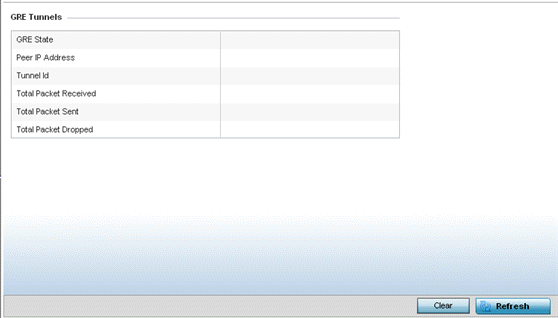AP GRE Tunnel
Generic Routing Encapsulation (GRE) is one of the available tunneling mechanisms which uses IP as the transport protocol and can be used for carrying many different passenger protocols. The tunnels behave as virtual point-to-point links that have two endpoints identified by the tunnel source and tunnel destination addresses at each endpoint.
Use the GRE Tunnel screen to view information on the traffic flow in a
Generic Routing Encapsulation
(GRE) tunnel.
To view the access point‘s GRE Tunnel statistics:
- Select the
Statistics menu from the Web UI.
- Expand the
System
node from the navigation pane (on the left-hand side of the screen). The System node expands to display the RF Domains created within the managed network.
- Expand an
RF Domain
node, and select one of it's connected access points. The access point's statistics menu displays in the right-hand side of the screen, with the
Health tab selected by default.
- Select
GRE Tunnel.
The
screen displays in the right-hand pane.
This screen describes the following:
| GRE State
|
Displays the current operational state of the GRE tunnel.
|
| Peer IP Address
|
Displays the IP address of the peer device on the remote end of the GRE tunnel.
|
| Tunnel ID
|
Displays the session ID of an established GRE tunnel. This ID is only viable while the tunnel is operational and does not carry to subsequent sessions.
|
| Total Packets Received
|
Displays the total number of packets received from a peer at the remote end of the GRE tunnel.
|
| Total Packets Sent
|
Displays the total number of packets sent from this controller or service platform to a peer at the remote end of the GRE tunnel.
|
| Total Packets Dropped
|
Lists the number of packets dropped from tunneled exchanges between this controller or service platform and a peer at the remote end of the VPN tunnel
|
|


 Print
this page
Print
this page Email this topic
Email this topic Feedback
Feedback